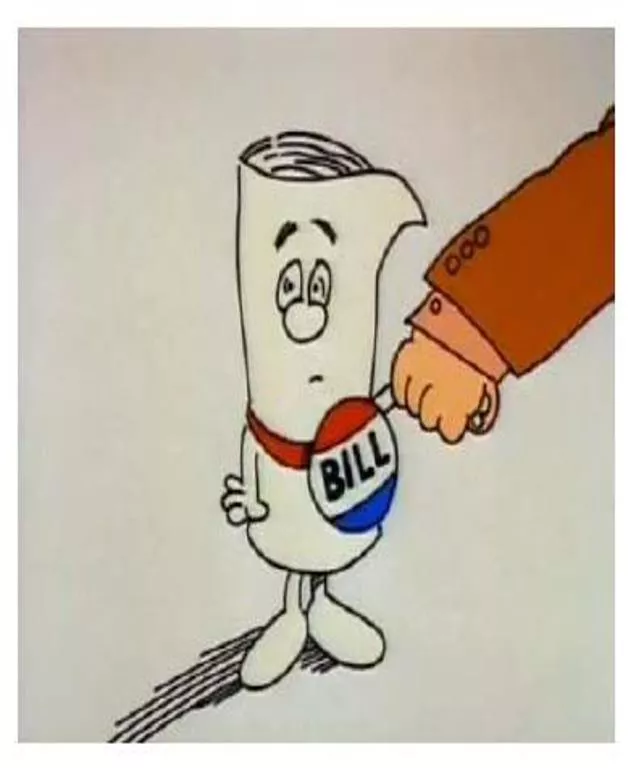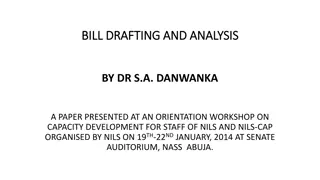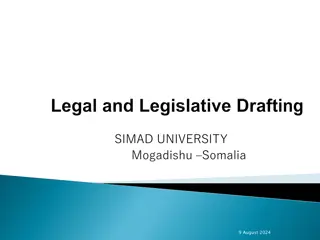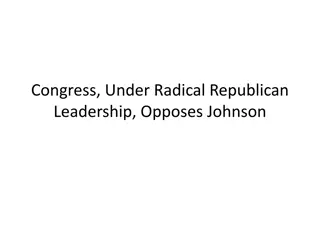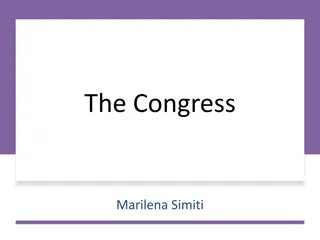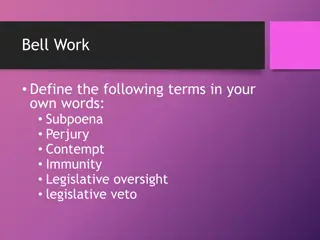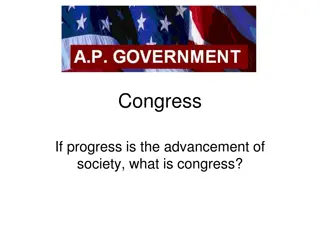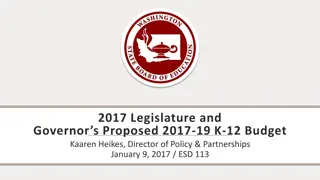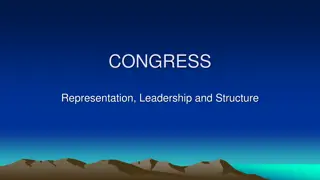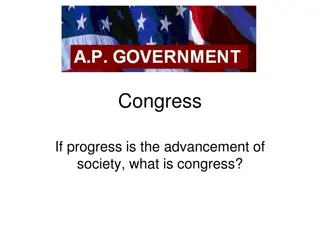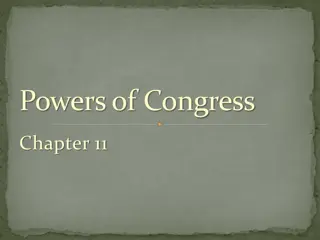Understanding the Legislative Process in Congress
Bills in Congress start as ideas introduced by members and can come from various sources. Senators and House members introduce bills, with some exceptions. The process involves submitting bills, holding hearings, assigning bills to committees, and potential amendment and debate stages. Different types of actions, such as joint resolutions and concurrent resolutions, are also discussed in the legislative process. Committees act as filters for bills, as most bills die in committee if not advanced for further consideration.
Download Presentation

Please find below an Image/Link to download the presentation.
The content on the website is provided AS IS for your information and personal use only. It may not be sold, licensed, or shared on other websites without obtaining consent from the author. Download presentation by click this link. If you encounter any issues during the download, it is possible that the publisher has removed the file from their server.
E N D
Presentation Transcript
Chapter 5: Congress: The Legislative Branch Section 5: The Legislative Process (pg.149-155)
Bills in Congress http://i95.photobucket.com/albums/l159/AmericanAlgora/Michigan%20American%20Legislative%20Exchange%20Council/ImJustaBillSchoolhouseRock.jpg Laws start out as bills introduced by members of Congress Ideas for bills come from constituents, interest groups, the president and members of Congress. Only a member of Congress can introduce a bill for consideration.
Introducing Bills Both senators and House members introduce bills. The one exception is that, tax bills and appropriation bills have to begin in the House. In the House the bill is dropped into a wooden box called a hopper. In the Senate a senator hands the paperwork to a clerk. Thousands are submitted during a session of Congress. A private bill affects only a particular person or group, and a public bill affects all of society. A bill may deal w/ a single topic or many topics. A rider may be added to a popular bill to get something unpopular to pass or a rider may be added as a poison bill to stop a popular bill from passing. http://2.bp.blogspot.com/-Dsa8SverCGw/TuqwUNX0r6I/AAAAAAAAAYQ/qqYD3uSp8mo/s1600/rider.png
Other Types of Action http://solstice.ischool.utexas.edu/projects/images/b/b5/Joint_Resolution_1145.jpg A joint resolution is much like a bill- it follows the same procedures as a bill and has the force of law if it passed by both houses and signed by the president. They are used in out-of-the-ordinary circumstances, like to propose constitutional amendments. Concurrent resolutions are used when both houses address matters that affect operations of both chambers or express an opinion. They are not signed by the president and don t have the force of law. Each chamber can pass resolutions that apply to matters of concern just within that chamber, like election of leadership or committee assignments.
Bills in Committee http://lowres.jantoo.com/law-policing-senate_hearings-hearings-committees-tortures-senate-16513476_low.jpg Committees act as a filter b/c most bills die in committee. A bill is assigned to a committee by the Speaker in the house and by the majority leader in the Senate, this is called referral. The next step is holding hearings, which are open to the public. The Chair of the committee or subcommittee has the power to control who appears at the hearings and how the public views the bill.
Bills in Committee http://otherwords.org/wp-content/uploads/2011/02/Un-Christian-Activities-Committee-Cartoon.jpg Following the hearing, a subcommittee must report on the bill to the full committee. They may report favorably of unfavorably (killing it) The subcommittees can also make amendments to the bill The markup is a meeting of the full committee and debate the bill further. They can kill the bill or they can include so many amendments that the bill is a new piece of legislation, called a clean bill. In the House, the majority of members may sign a discharge petition, forcing the bill out of committee.
House Rules As we saw in section 3 of this chapter the House Rules Committee acts as a traffic cop. Most bills must pass through this committee before reaching the full House. The rules assigned by the Rules Committee govern how the bill can be debated or amended by the full House. There are 3 main types: open, closed, & modified rules. They can also limit the debate on the bill. They can also kill the bill. http://www.mahablog.com/wp-content/uploads/2010/03/bill-schoolhouse-rock.jpg Bills can bypass the Rules Committee if two-thirds of the House agrees to suspend the rules
The Bill in the House The 1ststep in the process is the adoption of the rules put forward by the Rules Committee. The next step is to work as a Committee of the Whole. The reason they may do this is b/c it brings the quorum number down from 218 to 100. The Committee of the Whole debates the bill and amendments and they can add related amendments (although they don t always relate to the bill). The Committee of the Whole can t vote on the bill, it has to dissolve and let the full house vote. Most important votes are usually called record votes, which is sometimes called a roll-call vote. https://www.govtrack.us/static/images/img-voting-records.png
The Bill in the Senate http://i190.photobucket.com/albums/z205/JekyllnHyde_photos/August%2014%202012/filibuster.jpg The Senate doesn t have a Rules Committee nor do they use a Committee of the Whole. The Senate doesn t limit debate or the right to offer amendments. If a senator wants to place a limit on the bill it requires the unanimous consent of the Senate. This opens the door to filibuster or the Senate can end debate with three-fifths vote or 60 senators, on a cloture motion. When they are done debating they vote on the amendments & the bill. Important bills are often subject to roll-call votes.
The Conference Committee For a bills to be sent to the President they have to be passed in identical form by both houses. When there are major differences, members of a conference committee are drawn from each chamber. The conferees are chosen by the leaders of both houses. If they fail to reach an agreement the bill dies, but usually at this point the Conference Committee come to a compromise. The bill goes back to the floor of both houses for debate and if it passes both houses in it new version, the bill goes to the President s desk. https://cdn.andertoons.com/img/toons/cartoon5327.png
Presidential Action on a Bill The President can do three things with a bill 1. The President can sign the bill which makes it a law. 2.The President can hold on to the bill and if the Congress ends its session within 10 days the bill dies. This is called a pocket veto. 3. The President may veto the bill. President s usually have a veto message where they explain their specific objections. http://2.bp.blogspot.com/_4Y3MuWXqpUs/TBPRceqTXjI/AAAAAAAAAWM/GEl_nafqwZQ/s1600/07B+ChrisFlick-healthcare_bill.jpg



